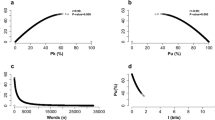Abstract
Students participated in a study (n=98) investigating the effectiveness of three types of annotations on three learning outcome measures. The annotations were designed to support the cognitive processes in the comprehension of scientific texts, with a function to aid either the process of selecting relevant information, organizing the information in memory, or integrating information with prior knowledge. Learning outcomes were measured by assessing student recall of facts, comprehension of the text, and mental model construction. Results show that different types of annotations facilitate different learning outcomes. In addition, we found that, compared to having only one type of annotation available, multiple types of annotations resulted in a higher cognitive load that resulted in lower performance, especially in tests of higher-level processing. This effect was stronger for low-verbal-ability learners, who showed lower peformance in treatments with multiple types of annotations than high-verbal-ability learners.
Similar content being viewed by others
References
Anderson, L. W., & Krathwohl, D. R. (Eds.). (2001).A taxonomy for learning, teaching, and assessing: A revision of Bloom's taxonomy of education objectives. New York: Longman.
Brünken, R., Plass, J. L., & Leutner, D. (2003). Direct measurement of cognitive load in multimedia learning.Educational Psychologist, 38, 5361.
Brünken, R., Plass, J. L., & Leutner, D. (2004). Assessment of cognitive load in multimedia learning with dual task methodology: Auditory load and modality effects.Instructional Science, 32, 115–132.
Carney, R. N., & Levin, J. R. (2002). Pictorial illustrationsstill improve students' learning from text.Educational Psychology Review, 14, 526.
Chandler, P., & Sweller, J. (1991). Cognitive load theory and the format of instruction.Cognition and Instruction, 8, 293332.
Chandler, P., & Sweller, J. (1992). The split attention effect as a factor in the design of instruction.British Journal of Educational Psychology, 62, 233246.
Chun, D. M., & Plass, J. L. (1997). Rffect of multimedia annotations on vocabulary acquisition.The Modern Language Journal, 80, 183198.
Chun, D.M., & Plass, J.L. (1997). Research on text comprehension with multimedia.Language Learning and Technology [Online serial], 1(1), 60–81.
Ekstrom, R.B., French, J.W., Harman, H.H., & Dermen, D. (1976).Kit of factor-referenced cogitive tests. Princeton, NJ: Educational Testing Service.
Jones, L.C., & Plass, J.L. (2002). Supporting listening comprehension and vocabulary acquisition with multimedia annotations.The Modern Language Journal, 86, 546–561.
Levin, J.R., Anglin, G.J., & Carney, R.R. (1987). On empirically validating functions of pictures in prose. In D.M. Willows & H.A. Houghton (Eds.),The psychology of illustration: Vol. I. Basic research (pp. 51–85). New York: Springer.
Macromedia. (2002). ColdFusion Server MX [Computer Software]. San Francisco: Author.
Macromedia. (2003). Flash 5 [Computer Software]. San Francisco: Author.
Mayer, R.E. (2001).Multimedia learning. New York: Cambridge University Press.
Mayer, R.E., & Moreno, R. (1998). Split-attention effect in multimedia learning: Evidence for dual processing systems in working memory.Journal of Educational Psychology, 90, 312–320.
Moreno, R., & Mayer, R.E. (2000). A coherence effect in multimedia learning: The case for minimizing irrelevant sounds in the design of multimedia instructional messages.Journal of Educational Psychology, 92, 117–125.
Paas, F., Renkl, A., & Sweller, J. (2003). Cognitive load theory and instructional design: Recent developments.Educational Psychologist, 38, 1–4.
Paivio, A. (1986).Mental representations: A dual-coding approach, New York: Oxford University Press.
Plass, J.L., Chun, D.M., Mayer, R.E., & Leutner, D. (1998). Supporting visual and verbal learning preferences in a second-language multimedia learning environment.Journal of Educational Psychology, 90, 25–36.
Plass, J.I., Chun, D.M., Mayer, R.E., & Leutner, D. (2003). Cognitive load in reading a foreign language text with multimedia aids and the influence of verbal and spatial abilities.Computers in Human Behavior, 19, 221–243.
Sweller, J. (1999).Instructional Design in Technical Areas. Camberwell, Victoria, Australia: Australian Council for Educational Research.
Sweller, J., Chandler, P., Tierner, P., & Cooper, M. (1990). Cognitive load in the structuring of technical material.Journal of Experimental Psychology: General, 119, 176–192.
Sweller, J., Van Merriënboer, J./J.G., & Paas, F. (1998). Cognitive architecture and instructional design.Educational Psychology Review, 10, 251–295.
Wittrock, M.C. (1990). Generative Processes of Comprehension.Educational Psychologist, 24, 345–376.
Author information
Authors and Affiliations
Corresponding authors
Rights and permissions
About this article
Cite this article
Wallen, E., Plass, J.L. & Brünken, R. The function of annotations in the comprehension of scientific texts: Cognitive load effects and the impact of verbal ability. ETR&D 53, 59–71 (2005). https://doi.org/10.1007/BF02504798
Issue Date:
DOI: https://doi.org/10.1007/BF02504798




